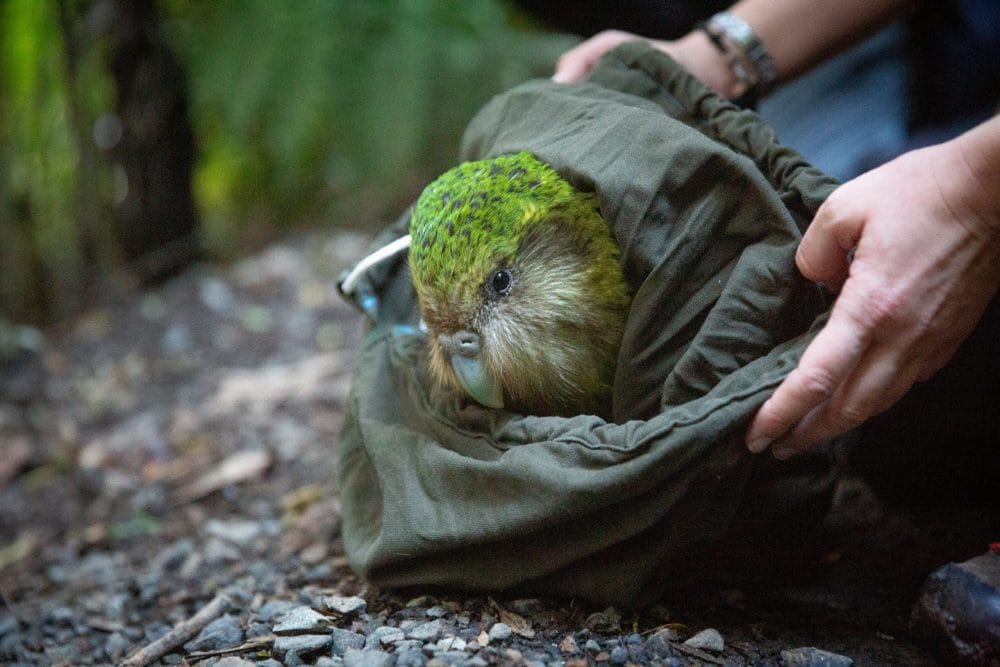A further six Ngāi Tahu kākāpō have been released at Sanctuary Mountain Maungatautari in Waikato following the successful settling in of four kākāpō earlier this year.
Around 100 people gathered to welcome the second batch of translocated kākāpō before they were released into the 3400ha protected forest habitat yesterday afternoon (13 September).
The Department of Conservation and Ngāi Tahu are investigating new habitat for kākāpō in a bid to reduce pressure on predator free islands ahead of future breeding seasons for the ground-dwelling forest parrots.
DOC’s Kākāpō Recovery Operations Manager Deidre Vercoe says the new population at Sanctuary Mountain Maungatautari will provide vital data to help support one of the programme’s long-term goals – to return kākāpō to their natural range throughout Aotearoa.
“By monitoring these birds over the next decade or so, we’ll know whether a larger kākāpō population could one day thrive and even breed on this mainland site.
“It’s too soon to know how kākāpō will do here long-term, but so far they seemed to be settling in well,” Deidre says.
“The first four all passed their health checks, and we are happy with how they have adapted to the new habitat. The latest translocation brings the total population to 10 males with a range of ages. This will be important as the younger males learn from the older birds.”
Kākāpō are a taonga species to Ngāi Tahu who are the traditional kaitiaki of the manu.
Te Rūnanga o Ngāi Tahu kākāpō Species Representative Tāne Davis is optimistic New Zealanders will one day see the manu taonga return to the whenua.
“Our Te Waipounamu forests are quiet without the boom of the kākāpō. Securing a strong population at Maungatautari is just the first step in achieving our shared vision of returning our manu to the mainland of our Ngāi Tahu takiwā.
“To save our kākāpō from extinction we have sent our taonga to our iwi partners, but one day we hope to see Rakiura/Stewart Island and other areas of the mainland predator free, so we can bring their uri (descendants) home.”
Sanctuary Mountain Maungatautari is a 3400ha fenced sanctuary in the rohe or home territory of iwi Ngāti Koroki Kahukura, Raukawa, Ngāti Hauā, and Waikato.
July’s translocation marked the first time in 40 years kākāpō had lived on the mainland of New Zealand.
Sanctuary Mountain Maungatautari Biodiversity Team Leader Dr Janelle Ward says having a further six kākāpō joining the sanctuary is incredibly special and a testament to the work put in by the community.
After the July release, the first four kākāpō spent time exploring and getting to know their new terrain, Janelle says.
“The first month of monitoring the four males at Maungatautari showed they have explored large areas of the maunga, including interacting with the fence, which underwent significant kākāpō-proofing for these excellent climbers.”
Co-chair of the Maungatautari Ecological Island Trust Board and representative of Ngāti Koroki Kahukura Norma Taute says it is a privilege to receive a further six taonga kākāpō so soon after the July transfer.
“We are very hopeful that with our combined efforts from all iwi, our community, landowners, council, DOC, and of course the attentive staff and volunteers on Sanctuary Mountain Maungatautari, we are providing kākāpō with the very best advantage to thrive.”
DOC’s Kākāpō Recovery Programme has been supported since 2016 by National Partner Meridian Energy, which provides funding as well as electrical infrastructure, technology and volunteering support to the programme.
Kākāpō Elwin, Kanawera, Manawanui, Tautahi, Taeatanga and Manaaki joined Bunker, Ōtepoti, Motupōhue and Māhutonga on the maunga yesterday.
The kākāpō came off Whenua Hou/Codfish Island, Pukenui Anchor Island and Te Kākahu-o-Tamatea/Chalky Island and were transported from Invercargill to Rotorua by Air New Zealand.

